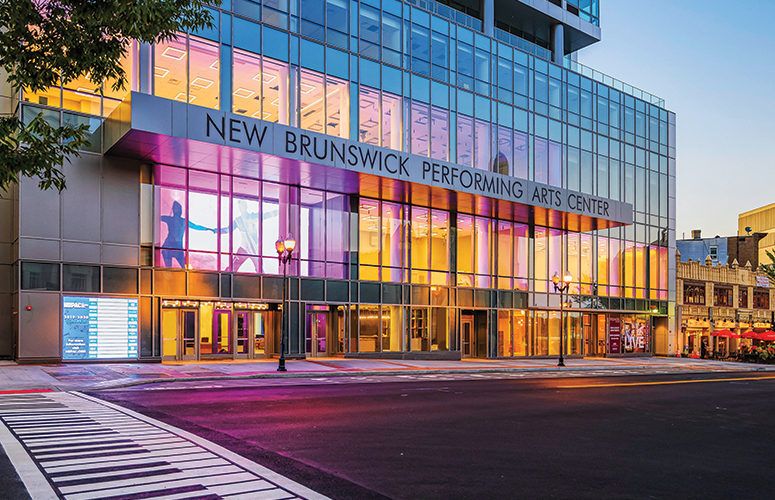
Central New Jersey’s Success
The low-down on economic developments within this five-county region.
By George N. Saliba, Managing Editor On Mar 16, 2015While New Jersey’s onerous tax structure and an uncertain economic climate have often been headline news, perhaps unsung is the fact that portions of the Garden State are steadily thriving, including much of Central New Jersey, which is comprised of: Somerset County, Monmouth County, Mercer County, Hunterdon County and Middlesex County. For instance, in 2014, the National Bureau of Economic Research ranked Somerset, Middlesex and Hunterdon counties among the “Top 10 Happiest Metro Areas” in the United States, and these counties have simultaneously experienced an array of economic developments.
A rich tapestry of diverse commercial interests (including life sciences companies), in addition to robust transportation infrastructure, quality-of-life amenities and high personal incomes are propelling the region to greater heights.
Somerset County

Other notable Somerset County developments include the much-heralded merger between Somerset Medical Center and Robert Wood Johnson University Hospital, which features investments at RWJ Somerset, such as: a bed management system, which provides hospital staff with real-time electronic information shared among all departments to help them more efficiently manage patient admissions, discharge and transports; the establishment of a gynecologic oncology program; renovation of the cardiac catheterization lab; and the merger of RWJ New Brunswick’s and RWJ Somerset’s sleep study labs.
Meanwhile, from a residential perspective, Edgewood Properties has built an upscale transit village in the heart of downtown Somerville named The Edge at Main, which is adjacent to the NJ Transit Rail Station and thus permits convenient commuting. This luxury residential community – which is now leasing units – features an on-site complement of quality dining, shopping and entertainment venues, in addition to a fitness center. In a similar vein, Capodagli Property offers the new Meridia Main Station in Bound Brook, which it states “offers luxury living at affordable prices.”
Higher education is likewise thriving in Somerset County, with Raritan Valley Community College expected to complete two projects by the spring and summer of 2016, respectively: The $9.5-million Whitman Science Center addition at 23,000 square feet, and a $8.5-million Workforce Training Center at 45,000 to 50,000 square feet. The latter will offer career training in advanced manufacturing, building systems (HVAC), personal care (cosmetology and fitness) and allied health.
From a parks and recreation standpoint, Somerset County reached an agreement with Montgomery Township to beautify an abandoned 240-acre psychiatric facility in Skillman, which has now become a gorgeous park system appropriately named Skillman Park.
In the broadest of terms, experts generally agree that for a region to thrive, it must have the capacity to attract Millennial Generation workers (persons born during or after the late 1970s), so that these individuals may act as a labor pool for hiring companies. On this point, Kerwin explains that the Somerset County Business Partnership has been collaborating with the Bloustein School of Planning and Public Policy at Rutgers University. Kerwin explains, “I said [to Dean James W. Hughes]: ‘Let me get this right: You have a class of Millennials? Graduate students? Why don’t we ask them what Somerset County needs to do to make ourselves attractive to Millennials?’ For the last three months, a class of students has been working on that issue, and they developed a report. I heard the presentation, and they were impressed [with Somerset County]. They did a walking tour of Somerville; they liked it. They appreciated the restaurants, bars and the Grand Train Station. There are a lot of amenities in the county. We need to get the word out to Millennials that we have got a lot going on, here.”
Middlesex County

Paladino adds, “Compared to 10 years ago, there are 5,000 people who didn’t live here, before. There are nine buildings that have been built over the last 10 years, and they house residents who are 24 to 30 year olds. They are living a different lifestyle: They want to be able to come home, go out and have a drink, see a show, have dinner, and – on Saturday morning – they want to go for a jog and stop at Starbucks. They want to be able to jump on the train. We find we have 200 housing units in the gateway building, and only 145 cars. They are walking and bicycling to work.”
While New Brunswick is increasingly a “hot spot” for Millennials, this has been facilitated by a broader landscape: During the last two years – in the first two phases of a transit village project – 200 housing units were built, in addition to: 80,000 square feet of office space, 2,000 parking spaces, and nearly 200,000 square feet of retail space, all adjacent and directly connected to the northeast corridor. Partners in the project include: Rutgers University, the New Brunswick Parking Authority, Robert Wood Johnson University Hospital, Devco and private developers. At this time, there is more than $300 million dollars’ worth of public/private partnerships with Rutgers University.
The College Avenue Redevelopment Initiative is noteworthy, especially against the backdrop of Rutgers’ entrance into the Big Ten Conference and the 2013 medical school and health sciences integration. Devco explains, “Devco, in partnership with Rutgers-The State University of New Jersey, and the New Brunswick Theological Seminary, has broken ground on a three-year, $330-million, 860,000-square-foot redevelopment initiative that will transform nearly 10 acres of the historic College Avenue campus in time for the 250th anniversary of the founding of Rutgers.”
Devco states that project includes: State-of-the-art academic facilities and modern student housing; campus environments with active green spaces and first-class retail; a unified College Avenue campus through extension of the historic Voorhees Mall; and one of the most significant public-private partnerships in state history, which uniquely uses New Jersey Economic Development Authority financing for higher education.
Regarding the future of New Brunswick, Paladino says, “If you look at population and other factors, we are very similar to Hoboken: We carve our own niche in the pantheon of great cities in New Jersey, in the metropolitan area. I think New Brunswick is going to be seen more as a center of innovation: The one place in New Jersey where there is the opportunity for real entrepreneurship and discovery in an urban environment. It is a place that’s very easy for partnerships to be built, between public and private sectors. New Brunswick is a manageable place, at five square miles. I can look out my window and see where the CEO of Johnson & Johnson, the president of Rutgers, the dean of the medical school and the president of Robert Wood Johnson hospital, sit. If I crane my neck, I can see where the mayor sits. New Brunswick is a place where you can see those people on the street, and whenever you can create a big-city feel in an environment of collegiality, great things happen.”
While New Brunswick is part of Middlesex County, the entire county is faring quite well, according to Freeholder Director Ronald G. Rios. He says, “We are in a unique position, because of our geographic location: We are minutes away from Port Elizabeth and we are halfway between New York and Philadelphia. We have numerous Fortune 500 companies. We have three universities, and a world-class healthcare and research facility. Middlesex County has long been a place where innovation and productivity have thrived. Additionally, we have a AAA bond rating, which is something that we are very proud of, and we worked hard to maintain that. We have every type of transportation mode available to us, between the New Jersey Turnpike, the Garden State Parkway, Interstate 287 and Routes 1 & 9 (the county also has rail lines). We are a county of over 825,000 residents, and growing. We are the second-largest populated county in the state.” By comparison, the entire state of Vermont has just 626,000 residents.
Johnson & Johnson and Bristol-Myers Squibb both call Middlesex County home, and an assortment of warehousing, distribution – and even farmland – diversifies the county and associated career choices for its residents.
Monmouth County

Monmouth County Freeholder Thomas A. Arnone says, “We’re unique compared to any other county because of the services that we have. Whether you want to enjoy farmland preservation and that type of environment, or if you want a beach-type atmosphere, we have it. Then, we have the people who just want to live a ‘normal, standard life,’ but they can avail themselves of fine dining and restaurants, and other functions, whether it is fairs or the race track. You might classify it as one-stop shopping, here.”
Contributing to Monmouth County’s quality of life are four hospitals: Riverview, Centrastate, Monmouth Medical and Meridian. In addition, Memorial Sloan Kettering Cancer Center will open a facility in Middletown in the fall of 2016, and, as the institution says, it will “provide comprehensive care via multidisciplinary care teams solely focused on cancer. Patients will benefit from access to personalized medicine, cutting-edge clinical trials, and cancer care for the whole patient, all offered under one roof.”
Home-builder Toll Brothers has also been constructing homes in Monmouth County’s Middletown, with the Estates at Bamm Hollow, an “estate home community.” Freeholder Arnone adds, “There’s potential retail development at the former Lucent site, and I know that is still being worked through.”
Meanwhile, at the closed military base Fort Monmouth, data management company CommVault has its new Tinton Falls headquarters, a 55-acre campus that triples the size of its former Oceanport location.
Of note, in Marlboro Township, a first-of-its-kind-in-the-United-States program has been established, and with great success: Residents who shop at participating local businesses have their property taxes reduced via each purchase they make. A card-based system was established with the assistance of Investors Bank, and Larry Rosen, Marlboro Township’s deputy mayor and director of economic development, says, “We have, right now – in our town – over 3,500 registered families, meaning households that have actually registered their cards. Registering their cards means entering their section blocks and lots online, so that every time they use their cards, and they are swiped at a participating vendors, they get credits on their tax bills. We have 50 businesses in Marlboro that are participating.”
In 2014, $1.3 million was spent in Marlboro using the Shop Marlboro property tax reward card, generating $66,000 in tax credits that were applied to residents’ tax bills. Since the program’s inception in September 2012, $2.5 million – and an associated $130,000 in tax credits – was earned. Rosen explains, “Everybody is happy: Our residents are happy because they are getting an added benefit, and our businesses are happy because they are getting more and more business. Also, the township is happy, because economic growth in our town is booming. We have shown constant growth even during the worst recession in recent history. We’ve had more development in this town – and more new businesses come into this town over the last five years – than I’ve ever seen. It’s been incredible. And it is because we are perceived as a very business-friendly town right now, and our municipality takes an active effort to promote local businesses.”
Hunterdon County

Hunterdon County Freeholder Matthew Holt says, “We have a very high quality of life in Hunterdon County, but, economically, there are some components that we need to address to revive and re-build the county. Right now, I would say our economy is probably in the range of about a ‘C’ to ‘C-.’”
Freeholder Deputy Director Suzanne Lagay says, “I would also say that we need to place more attention on retaining youth and attracting youth. All the [experts] say that companies are locating where workers are located. Today, workers are folks without cars, they are between the ages of 21 and 35, without families, and they want all kinds of entertainment and lifestyle options that we may or may not have in Hunterdon County. Now, that’s not to say that we aren’t looking to see what improvements can be made. But, right now, we don’t have it, with our lack of mass transportation, and our town centers not developed to attract that demographic.”
On a more positive note, Hunterdon Healthcare System continues to grow and attract physicians, residents, a population of health practitioners, and people who are interested in maintaining their health. It is a major employer, and shows signs of continued growth. Meanwhile, the former Bemis bag factory in Flemington and Raritan Township was sold in January is Jaja Global LLC, for $2.1 million, and the site will likely be developed. Additionally, a small retail area in Flemington was just purchased. Lagay says, “We don’t know the exact development plans there yet, but that’s very promising. So, there are good stories.”
Also promising is Hunterdon County’s farm and tourism industry, as well as its open space and parks. By all accounts, farm-to-table, tourism and wineries have an excellent future. Referring to the county overall, Lagay says, “We are very excited and hopeful about the future, because I think the things that we have identified are correctable. They are not going to happen tomorrow, but there is a population and a group of leaders – starting with the freedholders, and all our business leaders – who are willing to walk up to the line and say, ‘Let’s make sure that Hunterdon County stays in the wealth belt, albeit for new reasons.’”
Mercer County

While much has been said about Mercedes-Benz’s Mercer County warehouse moving out of state, Amazon.com
opened a massive, state-of-the-art fulfillment center in Robbinsville, which processes a staggering one million shipments daily. When it first opened, 700 employees were hired, and then employment increased to 1,400 during the months of October/November/December. At full capacity, it is anticipated the center will employ as many as 2,100.
Mercer County Executive Brian M. Hughes says, “From an economic development standpoint, Mercer County is wide open. Between Washington and Boston, we have three distinct and highly-used train stations that are used by both New Jersey Transit and Amtrak: The Trenton Station, Hamilton Station, and Princeton Junction. Overall, we have great location between Philadelphia and New York, and Boston and Washington.”
Mercer County has an array of higher education institutions, including Princeton University, Rider University and The College of New Jersey, as well as outstanding parks and recreation activities for the county’s residents. The county’s median household is $78,000. Hughes says, “I think all those things are going to keep Mercer County in good stead, moving forward, as the economy gets better.”
Conclusion
While New Jersey overall is experiencing numerous triumphs and challenges, so too are the five counties of Central New Jersey. Although they are geographically juxtaposed, each county has its own economic highlights – and in some case, concerns – that they will ride during the months, years and decades ahead. All told, Central New Jersey is as economically and socially diverse as the New Jersey’s other 15 counties, and Central New Jersey possesses a promising future, albeit with a few notable concerns.
Related Articles:






